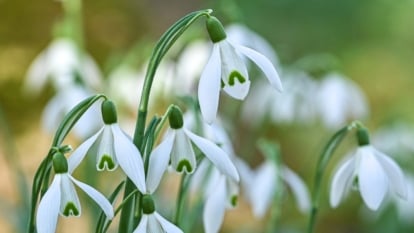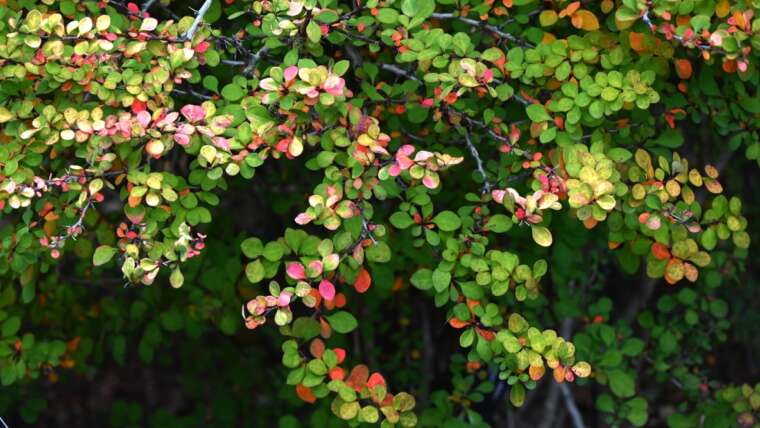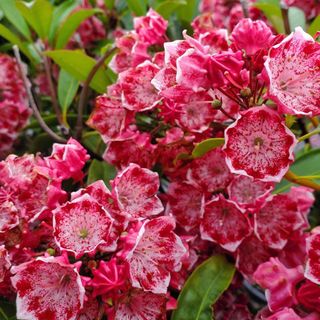Snowdrops bring delicate white, bell-shaped blooms and a light, fresh perfume to the late winter landscape. Often appearing through frosty ground, snowdrops bloom as early as January.
The very early-blooming perennial bulbs and their petite flowers have a durable nature. The carefree growers pop up even through the snow, with shoots of fresh green foliage and buds signaling winter’s end.
Plant the bulbs in the fall for a late winter and early spring show. Each plant boasts subtle beauty with simple, crisp white blooms. In sweeping drifts or tucked-in pockets, their sum exudes charm and effortless grace. This article explains when and how to plant snowdrops!
Snowdrops Overview
Snowdrop’s pendant, nodding white blooms carry a faint honey scent as an added delight that draws pollinators. The small plants present a lovely, naturalized appeal along walkways, borders, under tree canopy, in rock gardens, and on slopes. They also grow well in containers.
The low-growers achieve the most impact in groups. Plant them among groundcovers, perennials, spring ephemerals, bulbs, and cool-season annuals. Pair them with other late winter and early spring-flowering bulbs like winter aconite, glory of the snow, and early daffodils like ‘Tête-a-Tête.’
There are nearly 20 species of Galanthus in the Amaryllis (Amaryllidaceae) family, with hundreds of cultivars, some rare and highly sought after. The genus is native to Europe and southwest Asia, growing in cool mountainous regions, woods, and alpine meadows. Common snowdrops, G. nivalis, are widely available with four-inch-long leaves and one-inch flowers.
G. nivalis is an adaptable species, growing across USDA zones 3-9. Flowers usually appear in February or March, depending on winter conditions. Single and double-flowered cultivars are distinguishable by green markings on inner and outer petals.
Solitary blooms are white with six petals, three inner and three outer. The inner petals have a notched tip marked with green, and the outer flare slightly and may be pure white or brushed with mossy green, depending on the cultivar. Foliage is dark green and bladed, with three to four leaves per bulb.
The perennials thrive in partial shade to full sun in moist, humusy, well-drained soils, though they tolerate various types. Bulbs need a period of vernalization (a blast of winter chill) near 20℉ (-7°C) for vigorous growth. Deer and rabbits aren’t a bother, nor are pests or diseases.
When to Plant Snowdrops
 Plant them early in the fall when soil temperatures begin to cool.
Plant them early in the fall when soil temperatures begin to cool.
Fall is the best time to plant these and many other spring-flowering bulbs. Plant them as soon as available, early in the fall, and when soil temperatures begin to cool. Ideal nighttime temperatures are in the 40s and 50s (~4-10°C).
For even earlier blooms, plant snowdrops in a south-facing garden spot in full sun. The sun exposure warms roots and promotes early leafing and budding. Make sure to grow them in a visible area for easy viewing and enjoyment.
To grow bulbs in containers outdoors or to “force” them for indoor flowering, October is a good time to pot them up.
Prepare the Site
 To amend soils, topdress with a healthy layer of compost.
To amend soils, topdress with a healthy layer of compost.
The bulbs grow best in organically rich soils but tolerate various soil types, including clay. They prefer regular moisture but not prolonged saturation and usually don’t need supplemental irrigation with average seasonal moisture.
To amend soils, topdress with a healthy layer of compost. Incorporate it as you tuck in the bulbs. In poor soils (like clay), add organic material generously – it helps increase aeration and drainage while providing nutrients.
The low-maintenance growers perform beautifully under deciduous trees, which provide sun during the active growing season before trees leaf out. The dappled light later in the season protects the bulbs, and their leaf drop provides natural mulch for insulation and enrichment.
How to Plant
 When hand-planting, orient the root end at the base and the stem end upright.
When hand-planting, orient the root end at the base and the stem end upright.
Plant the petite bloomers in numbers, whether in drifts or pockets. Place them two to three inches apart and three to four inches deep.
For a natural effect, scatter them in clusters and cover them with soil. Lightly turn or dig a swath of ground and toss them in, returning the soil for a few inches of coverage, or hand plant each bulb.
When hand-planting, orient the root end at the base and the stem end upright. For scattering large numbers, I don’t worry about orientation, as the bulbs find their way up as they reach for the sun.
Forcing Early Blooms
 Partially fill the pots with mix and place the bulbs, covering them with an inch of soil.
Partially fill the pots with mix and place the bulbs, covering them with an inch of soil.
Like hyacinths, daffodils, and tulips, you can force snowdrops in containers into early flowering. Start with a well-draining potting media in a container (about four bulbs per four-inch pot, or go larger). Partially fill the pots with mix and place the bulbs, covering them with an inch of soil. Leave an inch or two of space beneath the pot’s rim before the soil level. Water well until it runs through the container and drainage hole.
For snowdrops to achieve their vernalization, place the pots outside a few weeks before autumn’s first frost. The fall placement encourages root development and assists with reaching cold temperatures of around 20°F (-7°C). An unheated cold frame or greenhouse works well, too.
If outdoors, nestle them close to a building or wall under a layer of leaves. They’ll receive adequate seasonal moisture. If indoors or undercover, keep the soil moist but not waterlogged.
After 10 to 12 weeks, check for buds. If you find leafy growth and budding stems, bring the potted bulbs indoors into a cool space (about 60°F or 16°C) with bright indirect sunlight. Move them to their display area when they are almost ready to flower. Keep the blooms cool at night to prolong flowering and keep them away from sunlight and heated drafts.
Post-Bloom Care
 Dig and divide the bulbs to expand their breadth in the garden.
Dig and divide the bulbs to expand their breadth in the garden.
The low-maintenance growers need little gardener intervention, flowering and growing freely with little care. Let foliage fade naturally after flowering. It yellows and browns in about six weeks. In that time, it continues to photosynthesize and direct nutrients to the bulbs for storage. This energy storage promotes overwintering and vigorous future growth.
While slower to naturalize than some other selections, snowdrops form large, tidy colonies over time. Dig and divide the bulbs to expand their breadth in the garden. Divide right after they flower in spring, when leaves are still green, and immediately replant the divisions and mother plants. Water them in after planting.
Popular Varieties
 The beloved charmers flourish in cool climates, with some better adapted to their upper growing range.
The beloved charmers flourish in cool climates, with some better adapted to their upper growing range.
The beloved charmers flourish in cool climates, with some better adapted to their upper growing range. From very early blooming to double flowers to tolerating warmer temperatures, there’s likely a lovely variety to brighten your garden.
‘Atkinsii’
 Its slender, pear-shaped outer petals frame the inner three, with a distinct green heart marked on their tips.
Its slender, pear-shaped outer petals frame the inner three, with a distinct green heart marked on their tips.
‘Atkinsii’ is an especially early-blooming variety. Its slender, pear-shaped outer petals frame the inner three, with a distinct green heart marked on their tips.
G. nivalis ‘Atkinsii’ is hardy in zones 3-8 and reaches eight to ten inches tall. The delicate beauty is a recipient of the Royal Horticulture Society’s Award of Garden Merit.
‘Flore Pleno’
 The white outer petals hold a ruffled interior with a painterly swirl of green streaks.
The white outer petals hold a ruffled interior with a painterly swirl of green streaks.
G. nivalis ‘Flore Pleno’ has a unique double flower. The white outer petals hold a ruffled interior with a painterly swirl of green streaks.
This attractive and robust variety is another RHS Award of Garden Merit winner. The plants reach six to ten inches tall and are hardy in zones 3-8.
‘Viridi-apice’
 This variety has unique green tips on its pure white inner petals and green blotches on its outer layer.
This variety has unique green tips on its pure white inner petals and green blotches on its outer layer.
‘Viridi-apice’ has unique green tips on its pure white inner petals and green blotches on its outer layer. It brings a fresh look and a more robust habit than the species. Hardy in zones 3-7, it reaches six to ten inches tall.
Giant Snowdrops
 Petals have a more prominent green blotch.
Petals have a more prominent green blotch.
G. elwesii, or giant snowdrops, are a showy selection with larger leaves and flowers that reach up to two inches. Petals have a more prominent green blotch.
The “giants” reach 14 to 16 inches tall and are hardy in zones 4-7, with some success up to zone 9, where plants may be shorter-lived. G. elwesii is a good selection for warmer climates as they withstand warmer winter and spring temperatures better than others. These snowdrops perform best when planted in the coolest part of the season.
Frequently Asked Questions
These bulbs grow indoors after a cooling period (vernalization at 10-12 weeks in temperatures near 20°F or -7°C). Force them to bloom by bringing potted bulbs inside after sufficient cool exposure when leafy growth and stems are present. Keep them in a cool area until just about to flower, when they can move to their display spot.
The naturalizing perennials spread through seeding and bulb offsets. They slowly form compact colonies to leave undisturbed or to divide to expand the collection. They’ve naturalized in parts of eastern North America, including North Carolina and Virginia, but aren’t considered invasive.
Snowdrops contain levels of mild toxicity. To avoid ingestion, keep them away from curious critters and children. Some people experience minor skin irritation when handling them. Wear your garden gloves to be on the safe side.




